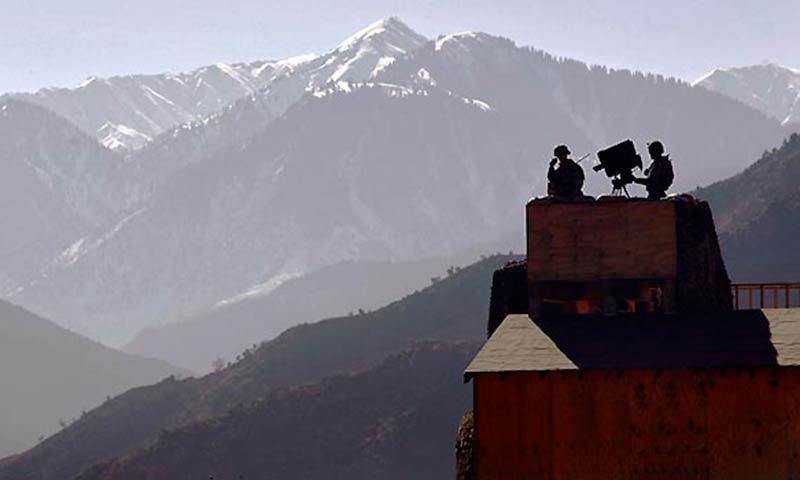He picked up the ball and clutched it longingly to his chest as he scoured the expanses of the pitch in front: a silted, sluggish creek, about thirty metres wide, the bushes on its opposite bank calling out the challenge.
“I can kick it all the way to the other side,” Wafadaar boasted, putting the ball on the floor and positioning his foot firmly on its curved edge. The other kids gathered around him, some bent over with their hands on their knees, a few fretfully running their fingers through their hair.
Wafadaar bounced the ball a couple of times and, finally, booted it as far into the opposite direction as his little body could manage, comfortably landing the ball into a bush on the other side of the water. The children roared.
“Now we have to go to the other side and get the ball,” Wafadar said. Before I could stop him, my self-appointed guide, he was racing down the narrowing street, avoiding heaps of rubbish and craters in the ground, dribbling an invisible ball, always moving — on grass and on gravel, on the road and on mud and through water, disappearing behind a cluster of houses. I needed a new guide to help me find the elusive colony of people displaced by the Kargil conflict and living somewhere behind Islamabad’s Bari Imam shrine. Wars between Pakistan and India have claimed thousands of victims but forgotten among them are the living victims of the Kargil war who have sought uncertain refuge in the squalor of shanty towns around the country.
Across a bridge and up and down narrow streets lined with palm trees and mud and brick houses, their doors painted in shades of orange and green, Baqir, our pied piper, led me and a long line of local children to a small hamlet teetering on the edge of the creek. A sheepish Wafadar found us again somewhere along the way. “Why did your family move here?” I asked him. “I don’t know,” Wafadaar said. “Ask my father.” Something terrible had happened to Wafadar’s father — something senseless but dreadfully common among hundreds and thousands of people who have been displaced from several parts of Pakistan brutalised by war.
A sepahi in the Pakistan army, Shah returned to his village across the border from Kargil one morning to find that an Indian shell had crashed through the roof of his two-storey house and left his son and daughter dead. His second daughter, 10-year-old Sidra, was lying semi-conscious under a tree, her skull crushed by the bombardment.
As he gathered his children’s bodies, Shah says he remembers fretting that the bales of hay stacked on the roof for the goats’ winter fodder had caught fire during the shelling. He worried for his animals. A few days later, after India blocked water to the area, Shah fled, his bleeding daughter bundled in his arms. Sidra died a few days later.
But grief and remorse trailed him to Islamabad, combining with other stresses: financial troubles and the absence of support from relatives and friends. Fifteen years later, Shah is a driver at the Earthquake Reconstruction and Rehabilitation Authority, surviving on a meagre salary and a Rs5,000 pension. He blames Nawaz Sharif. “Kashmir was in our hands,” he told me at his house, sitting in a blue plastic chair under harsh fluorescent lights and a clock that read 6:54, no longer keeping time.
“But then Sharif went to the United States and we had to give Kargil back.” For Shah, and his neighbours, many of them ex-army men, Sharif’s greatest betrayal was calling the Kargil fighters mujahideen. “Kashmiri mujahideen?” he scoffed. “He said we were mujahideen! I’m retired from the army. He disowned his own army.” While Shah has never been compensated for what he left behind, and several trips to the GHQ have borne nothing, Sharif will travel to India next week to make gains for the future.
A neighbour’s son Ali Raza, now 20, also remembers shells: exploding Indian shells dripping like rain every day on his way to school. A shell fell near his school bus once, so close it rocked the bus from the side to side. He tells me about the 12-year-old girl whose nose was sliced off by shrapnel. He also tells me about how the war changed children’s lives — and their toys too.
“They [army] would give us one gola (grenade) each and send us to throw them on the Indians,” Ali, a cook at Nadra, said. “The children were small and were hard to detect at night. And plus we knew all the inside routes that even the adults didn’t. So they gave us a gola each and off we went, running up the hills.”
As Ali tells me about the unusual toys and the invented games, his infant daughter plays with a rattle by his feet. She chuckles. At least for her, one can pray, the war is over.
Published in Dawn, May 25th, 2014














































